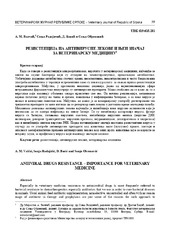Приказ основних података о документу
Rezistencija na antivirusne lekove i njen značaj za veterinarsku medicinu
Antiviral drugs resistance - importance for veterinary medicine
| dc.creator | Valčić, Miroslav A. | |
| dc.creator | Radojičić, Sonja | |
| dc.creator | Bacić, Dragan | |
| dc.creator | Obrenović, Sonja | |
| dc.date.accessioned | 2021-07-07T09:02:12Z | |
| dc.date.available | 2021-07-07T09:02:12Z | |
| dc.date.issued | 2012 | |
| dc.identifier.issn | 1840-2887 | |
| dc.identifier.uri | https://vet-erinar.vet.bg.ac.rs/handle/123456789/2096 | |
| dc.description.abstract | Kada se govori o rezistenciji mikroorganizama, naročito u veterinarskoj medicini, najčešće se misli na sojeve bakterija koji su otporni na hemioterapeutike, prevashodno antibiotike. Uobičajeno dodavanje antibiotika stočnoj hrani, neselektivna, nekontrolisana i često bezrazložna upotreba antibiotika u terapiji i preventivi samo su neki od razloga za ovakav prilaz rezistenciji mikroorganizama. Međutim, u proteklih nekoliko decenija, jedna od najintenzivnijih sfera istraživanja farmaceutske industrije su antivirusni preparati. Može slobodno da se kaže da se o virusima koji izazivaju oboljenja sisara praktično sve zna. Od načina replikacije, mehanizama kojima patogeno deluju na tkiva i organe, ponašanja u inficiranim ćelijama, a za neke viruse je poznat i celokupni genetski kod. Međutim, do danas je za komercijalnu upotrebu registrovano tek tridesetak preparata uz male izglede da se repertoar ovih lekova u dogledno vreme značajnije poveća. Mehanizam delovanja antivirusnih lekova najčešće je inhibicija neke virusne aktivnosti koja je neophodna da se odigra infekcija na nivou ćelije. To su inhibicija adsopcije virusa, fuzije virusa sa ćelijom, uklanjanja virusnih omotača, inhibicija virusnih enzima (virusne DNK polimeraze, reverzne transkriptaze, virusnih proteaza, neuraminidaze, dehidrogenaza i hidrolaza) kao i inhibicija sinteze virusne RNK. Pored potencijalnog značaja nastanka rezistentnih virusa u slučaju da se upotrebe antivirusni preparati kod životinja male (luksuzne) prakse, postoji i opasnost metafilaktične primene antivirusnih lekova kod onih vrsta životinja koje se koriste za ishranu ljudi, za profilaksu virusa koji izazivaju značajne zoonoze. | sr |
| dc.description.abstract | Especially in veterinary medicine, resistance to antimicrobial drugs is most frequently referred to bacterial resistance to chemotherapeutics especially antibiotics that we use in order to cure bacterial diseases in animals. Usual animal feed antibiotic supplementation, nonselective, uncontrolled and often with no reason usage of antibiotic in therapy and prophylaxis are just some of the reasons for such approach to microorganism’s resistance. However, in last few decades development of antiviral drugs is one of the most intensive fields of the work of the pharmaceutical industry. One can easily say that there are a few unanswered questions as far as viruses that cause disease of mammals are concerned. As a science, virology is aware of all aspects of virus biology and infectology. Mechanisms of the virus replication, pathogenic pathways in infected hosts and all aspects of virus biology are well known. Moreover, for most of the important viruses, whole genetic base has been elucidated. In spite of that, up to now there are not more than thirty commercially registered antiviral drugs with a little chance this number to increase. Antiviral repertoire most frequently is inhibition of some virus activity such as virus adsorption, fusion with the cell, virus uncoating, inhibition of virus enzymes (DNA polymerase, reverse transcriptase, neuraminidase, protease, dehydrogenase and hydrolase) as well as virus RNA replication. Apart of the potential importance as a part of the therapy in small-luxury veterinary praxis, antivirus drugs are potential hazard if they are used as a part of metaphylaxis in order to prevent diseases in the animal species that we use as a food. At the same time there is a risk of virus becoming resistant in case of using antiviral drugs in the prophylaxis of the zoonoses. | sr |
| dc.language.iso | sr | sr |
| dc.publisher | Banja Luka : PI Veterinary Institute Republic of Srpska „Dr. Vaso Butozan“ | sr |
| dc.relation | info:eu-repo/grantAgreement/MESTD/Technological Development (TD or TR)/31088/RS// | sr |
| dc.rights | openAccess | sr |
| dc.rights.uri | https://creativecommons.org/licenses/by/4.0/ | |
| dc.source | Veterinarski žurnal Republike Srpske | sr |
| dc.subject | rezistencija | sr |
| dc.subject | antivirusni lekovi | sr |
| dc.subject | veterinarska medicina | sr |
| dc.subject | resistance | sr |
| dc.subject | antiviral drugs | sr |
| dc.subject | veterinary medicine | sr |
| dc.title | Rezistencija na antivirusne lekove i njen značaj za veterinarsku medicinu | sr |
| dc.title | Antiviral drugs resistance - importance for veterinary medicine | sr |
| dc.type | article | sr |
| dc.rights.license | BY | sr |
| dcterms.abstract | Радојичић, Соња; Обреновић, Соња; Бацић, Драган; Валчић, Мирослав A.; Резистенција на антивирусне лекове и њен значај за ветеринарску медицину; Резистенција на антивирусне лекове и њен значај за ветеринарску медицину; | |
| dc.citation.volume | 12 | |
| dc.citation.issue | 1 | |
| dc.citation.spage | 39 | |
| dc.citation.epage | 46 | |
| dc.identifier.fulltext | https://vet-erinar.vet.bg.ac.rs/bitstream/id/5720/Rezistencija_na_antivirusne_pub_2012.pdf | |
| dc.identifier.rcub | https://hdl.handle.net/21.15107/rcub_veterinar_2096 | |
| dc.type.version | publishedVersion | sr |

